Spirit of Glen Ellyn, 1903 Wright Flyer Replica, Goes
136 Feet (or 144)
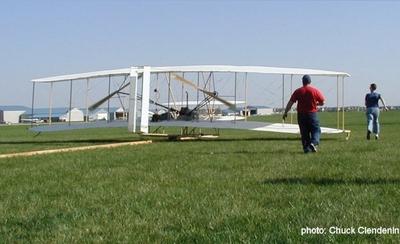
The Wright Redux Association's 1903 Wright Flyer replica,
Spirit of Glen Ellyn, went airborne Sunday at Clow
International Airport in Bolingbrook (IL), flying 136 feet from the
end of the launch rail.
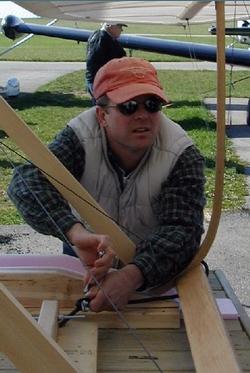 At
4:45 PM, pilot Ken Kirincic (right) throttled the plane's engine
and launched himself and Wright Redux into history, becoming the
first 1903 Wright Flyer replica to achieve free, powered
flight.
At
4:45 PM, pilot Ken Kirincic (right) throttled the plane's engine
and launched himself and Wright Redux into history, becoming the
first 1903 Wright Flyer replica to achieve free, powered
flight.
"The conditions were perfect," said Kirincic, who hails from the
Illinois city of Glen Ellyn. "I knew when we released the machine
into the 15 mph southerly wind and felt it gain a lot of speed
going down the launch rail that we had a good chance to get the
Spirit of Glen Ellyn off the ground. The plane took to the
air beautifully and I managed to land it without any damage."
The flight was the culmination of a four-year effort to fund,
build and fly an exact replica of the 1903 Wright Flyer. Working
primarily from information in the Wright Brothers' journals,
original Wright photographs, and information obtained from the
National Air and Space Museum, the Wright Redux Association
succeeded where many have failed.
"It's hard to describe what yesterday's flight means to this
group," said Co-President, Mark Miller. "All the work and all the
planning came down to one moment. It just came together
unbelievably well. I can't say enough about this group of people.
Sunday's result just goes to show you what determination,
persistence, and today, a little bit of luck can lead to. I am
mighty proud to be a part of this effort and continue to be awed by
what Orville and Wilbur Wright accomplished 100 years ago."
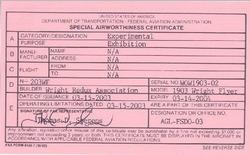 Ted Craft, Wright Redux Co-President, pointed out,
"[This] was the culmination of a lot of difficult -- but it appears
correct -- decisions made by this group. So much of what we
did had no plan. Chasing the solutions to the multitude of problems
we faced was at times hard. There were moments when I wondered how
the Wright Brothers accomplished what they did. But after watching
our plane fly, I am extremely pleased with everything we decided to
build into our plane. The wing solution; the propeller solution;
the gearing solution... all proved to be correct, and the
Spirit of Glen Ellyn performed remarkably well."
Ted Craft, Wright Redux Co-President, pointed out,
"[This] was the culmination of a lot of difficult -- but it appears
correct -- decisions made by this group. So much of what we
did had no plan. Chasing the solutions to the multitude of problems
we faced was at times hard. There were moments when I wondered how
the Wright Brothers accomplished what they did. But after watching
our plane fly, I am extremely pleased with everything we decided to
build into our plane. The wing solution; the propeller solution;
the gearing solution... all proved to be correct, and the
Spirit of Glen Ellyn performed remarkably well."
Flew better on its own than in tow...
"We damaged the plane on Saturday and again on Sunday during our
tow tests and overcame both of these to go on and fly the 'Spirit
of Glen Ellyn' on Sunday afternoon," said Mike Perry,
Secretary/Treasurer of Wright Redux. "This Wright Redux team never
gives up. We repaired the machine after the last crackup and what
you saw Sunday afternoon was the result of pure determination. I
believe the spirit of Wright Redux is similar to the attitude the
Wrights demonstrated 100 years ago."
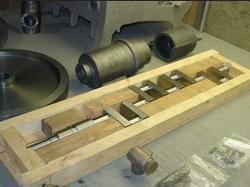 "The Wright Redux team is to be commended for this
flight," said Ken Packer, PhD, PE, Chief Engineer of Packer
Engineering. "Our team has been in love with this project since we
first got involved. We are happy to contribute our expertise to
this endeavor. It is exciting to participate in recreating the
accomplishments of the Wright Brothers. The next milestone is to
fly again, using the replica engine that our team is building for
the Flyer."
"The Wright Redux team is to be commended for this
flight," said Ken Packer, PhD, PE, Chief Engineer of Packer
Engineering. "Our team has been in love with this project since we
first got involved. We are happy to contribute our expertise to
this endeavor. It is exciting to participate in recreating the
accomplishments of the Wright Brothers. The next milestone is to
fly again, using the replica engine that our team is building for
the Flyer."
Packer Engineering was instrumental in the success of this
accomplishment. Their aeronautical engineering expertise was
critical to achieving FAA certification of the "Spirit of Glen
Ellyn" as an Experimental Exhibition aircraft, the testing regimens
and to the success of the first flight attempt. Packer also
machined and built the engine, from donated sand castings and
forgings (above).
 As happens so often on historic flights, the pilot
choice was somewhat by chance.
As happens so often on historic flights, the pilot
choice was somewhat by chance.
Mike Perry told ANN, "Mike Gillian was originally slated to have
been the pilot [on the first flight]." They weren't really planning
to fly on Sunday. Stuff happened. Mike: "At the beginning of the
day, we snapped part of the skid, while tow-testing. We had to glue
it back together. While the glue was drying, we had a meeting, and
a debate. We decided that, 'if we're going to keep breaking this
thing while we're towing, we might as well break it while flying
it.'" Gillian (immediately below, after original tow tests) wasn't
available; Kirincic was.
First time's the charm.
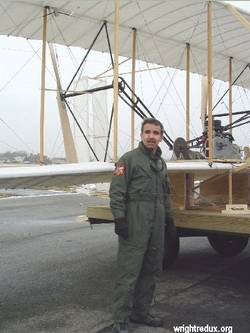 Mr. Perry told us, "We didn't use any auxiliary
power -- the Wrights didn't use the catapult until 1904, when they
went back to Huffman Prairie (because of not enough headwinds)...
We had three attempts -- the first was the best; the second two --
we just got up about six inches -- it just never really got off.
Without the wind, we tried two more times, and we couldn't do
it.
Mr. Perry told us, "We didn't use any auxiliary
power -- the Wrights didn't use the catapult until 1904, when they
went back to Huffman Prairie (because of not enough headwinds)...
We had three attempts -- the first was the best; the second two --
we just got up about six inches -- it just never really got off.
Without the wind, we tried two more times, and we couldn't do
it.
"The first flight was 136' 3" from the end of the rail. That's
about 144 feet total, since it was flying before it got to the end
of the rail," Mike told us.
Busted, a little.
After the first flight, they tried twice more -- and succeeded,
in a manner of speaking; but without the winds, the Wright
Flyer didn't live up to its name. "On the third flight,
the wire that crosses the landing skids got caught up in the
takeoff dolly -- the dolly (bottom photo) did kind of a
'cart-flip,' and it broke [a little part] at the rear of the
airplane. If we had gained more altitude, it wouldn't have
happened. We learned a lot yesterday," the group's treasurer
said.
How fast did she go?
We won't know how fast it went, until some more analyses are
made. Mike was frank: "Because we weren't really ready, we didn't
have a radar gun on it. We may look at the film; and there's a
stopwatch -- we know how far it went, so we'll be able to figure it
out."
Fly again?
The Spirit of Glen Ellyn will fly on the front lawn of
the Chicago Museum of Science and Industry on September 20-21, 2003
as the highlight of the City of Chicago's observance of the
centennial of the Wrights' first flight in 1903. Following those
flights, the plane will be donated to the MSI where it will be
displayed as part of the museum's permanent aviation
collection.
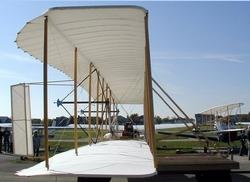 What about another flight, before the lawn of the
Museum? Mike told ANN that, "We haven't discussed that yet within
our group. There's a lot of 'risk-averse' attitude in the group,
understandably. Now that we've done it, we are going to consider
flying, more."
What about another flight, before the lawn of the
Museum? Mike told ANN that, "We haven't discussed that yet within
our group. There's a lot of 'risk-averse' attitude in the group,
understandably. Now that we've done it, we are going to consider
flying, more."
Flew pretty well...
Mike continued, "Our pilot loved it -- he wanted to keep going,
but the winds just died. Ken did an awesome job. He could have gone
further -- he was straight and level, 12 to 24 inches off the
ground. We didn't see any of the porpoising that people say this
plane should have." Perhaps that was because, as Mike told
us, "Ken was very precise and minute, with his inputs."
Pilot training in Ohio
Mr. Perry wanted to thank the glider people for some fortuitous
flight training. "We have to give some credit to Nick Engler and
his group in Dayton. He let us fly his 1900, 1901, and 1902
[Wright] gliders. Ken and Mike both got to fly those -- the
experience was extremely beneficial and positive for them." The
flight training took place on a very cold day, several weeks ago,
at Warren Dunes, in Indiana. The gliders, Mike told us, "...were
launched by people, holding onto ropes, and running down the
dunes." just like a hundred years ago.
The Engler group, Mike said, were "incredibly generous, and
really beneficial to our pilots. We just don't have the funding to
build those gliders, to learn how to fly on."
How much?
Mike's the treasurer, so he's perhaps closer to the dollars,
such as they were, that came together to build this machine. "The
Flyer was built for about $60,000, actual cash," he said,
but that wasn't the bulk of the expense. He added, "...plus
donations of raw material and work. The engine alone was -- we had
quotes of 6 months, and $100,000 to $200,000." Here's just one
example of how donations of time and expertise made the project
possible: "Packer Engineering built the engine with donated
materials, forgings, sand castings -- and they're donating their
time and machining."
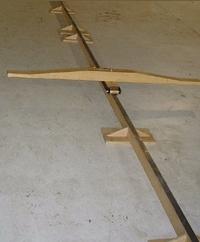 Tom Norton (who has since moved to the DC area)
and Mark Miller founded the Wright Redux Association in 1999. These
two Glen Ellyn men set out to build and fly an exact replica of the
Wright 1903 Flyer, a feat never before accomplished. Neither Norton
nor Miller is a pilot, and neither had previously attempted to
build a flying aircraft. As the project continued, several talented
volunteers joined the Wright Redux team. Along with Ted Craft and
Mike Perry, principal Wright Redux workers included: Chuck
Clendenin, Turk Tilev, Jeff Knuckles, Bill and Jean Mumford, Erin
Norton, and Rick Perry.
Tom Norton (who has since moved to the DC area)
and Mark Miller founded the Wright Redux Association in 1999. These
two Glen Ellyn men set out to build and fly an exact replica of the
Wright 1903 Flyer, a feat never before accomplished. Neither Norton
nor Miller is a pilot, and neither had previously attempted to
build a flying aircraft. As the project continued, several talented
volunteers joined the Wright Redux team. Along with Ted Craft and
Mike Perry, principal Wright Redux workers included: Chuck
Clendenin, Turk Tilev, Jeff Knuckles, Bill and Jean Mumford, Erin
Norton, and Rick Perry.
Primary financial and material sponsors of the Wright Redux
Association are The Museum of Science and Industry, National
Geographic, The Wheaton-Glen Ellyn Community Bank, The Glen
Ellyn Jaycees, Packer Wings, NFP and the Horn Lumber Company of
Chicago.
[Thanks to the Wright Redux folks and Chuck Clendinin for
the photos --ed.]
 ANN's Daily Aero-Linx (04.13.24)
ANN's Daily Aero-Linx (04.13.24) ANN's Daily Aero-Term (04.13.24): Beyond Visual Line Of Sight (BVLOS)
ANN's Daily Aero-Term (04.13.24): Beyond Visual Line Of Sight (BVLOS) Airborne 04.09.24: SnF24!, Piper-DeltaHawk!, Fisher Update, Junkers
Airborne 04.09.24: SnF24!, Piper-DeltaHawk!, Fisher Update, Junkers Aero-News: Quote of the Day (04.14.24)
Aero-News: Quote of the Day (04.14.24) ANN's Daily Aero-Term (04.14.24): Maximum Authorized Altitude
ANN's Daily Aero-Term (04.14.24): Maximum Authorized Altitude










